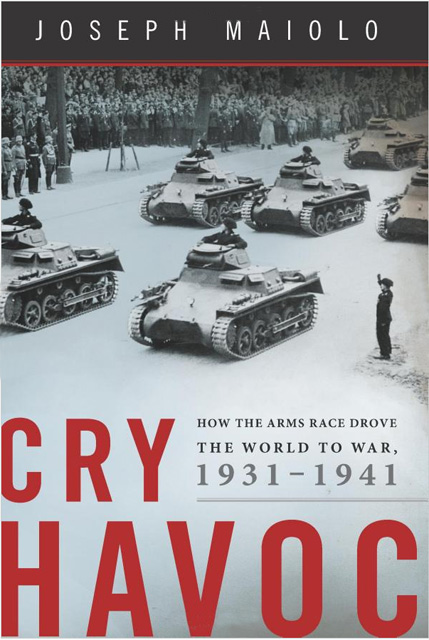 Cry Havoc
Cry Havoc
How the Arms Race Drove the World to War, 1931–1941
By Joseph Maiolo. 504 pp.
Basic, 2010. $35.
Appeasement: it’s one of America’s dirtiest words. We all know it means cravenly surrendering democratic ideals in the face of totalitarian military might, and that it caused World War II. But author Joseph Maiolo recasts what appeasement meant at the time. In the unstable decade before the war, when the Depression had flattened economies worldwide, the relentless military-industrial buildup that every major nation—including the United States—eventually joined was the true propellant pushing the globe to yet another brink.
In that grim context, for instance, British prewar policy wasn’t the complete sniveling idiocy it can seem in retrospect. Not just the spawn of cowardly and blinkered politicians, appeasement was the diplomatic face of deterrence, Britain’s only viable military strategy in an all-out continental war. In the short-to-intermediate term, however unevenly or ineptly they executed the policy, the Brits were focused on buying time to revamp their economy for total war—just like everyone else. That’s because all the major powers agreed on one thing: they were sure that what was clearly coming, whether they craved it or feared it, would almost inevitably evolve into a long, ghastly struggle of attrition. And the nations with the biggest, least vulnerable, best prepared economies would eventually win.
Expanding on work by A. J. P. Taylor, Adam Tooze, and Norman Stone, Maiolo emphasizes how everyone on all sides learned this vital lesson from World War I and put it to various uses. He unearths how the political economy of total war evolved during the interwar period—a daunting subject, and easily turned drier than dust. But Maiolo combines his numbers-crunching research with a storyteller’s flair for scene setting and character. His command of his vast canvas’s moving parts humanizes the torrents of data. In the process, he also reminds us that events in the late 1930s posed immense questions, especially for open societies facing aggressors with a jump on the global arms race and a willingness to play chicken.
What happens when you transform a fractious democratic society into one completely girded for war? How long before the command-and-control aspects of a militarized economy overwhelm or permanently subvert notions like individual freedom? How much censorship and propaganda can be dished out before the habit of indoctrination and credulity becomes ingrained in government and people alike? How do you fight totalitarian opponents in a total war effectively, without eventually becoming just like them? These uncomfortable questions have
profound echoes in our tangled times.
Most of the wildly varied perspectives Maiolo has synthesized clashed at some point in the prewar maze of half-truths, misunderstandings, intrigue, deceit, bluffs, projection, even stabs at reason. His hundreds of characters shared the fog of preparing for war. They desperately, confidently, hopefully read everyone else’s intentions to figure out the next moves in the arms and economic races. We have the comfort of knowing how it turned out. But reading history backward is usually the least successful way to learn its lessons. Maiolo’s meticulous work reveals what was really at stake in that deeply troubled prewar decade, and why. In the process, he makes “appeasement,” the dirty word we use to label and dismiss those extraordinarily complicated times and decisions, subject to more informed—and hopefully useful—debate.




